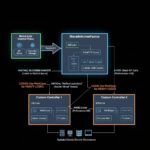
This blog post dives into the world of generative AI and how real-time streaming data enhances its capabilities. Generative AI models, like large language models (LLMs), excel at various tasks such as text generation, chatbots, and summarization. However, they traditionally rely on static datasets, limiting their adaptability to ever-changing information.
Why Streaming Data Matters
Streaming data offers a continuous flow of fresh information, empowering generative AI applications to:
- Respond promptly: Imagine a travel chatbot that integrates real-time flight availability, pricing, and hotel data. Streaming ensures the chatbot provides the most up-to-date information for optimal customer guidance.
- Adapt to changing conditions: Anomaly detection systems powered by generative AI can leverage streaming data to instantly identify and notify operators of critical situations, maximizing effectiveness.
Challenges of In-Context Learning
LLMs struggle with in-context learning, where they adapt responses based on the situation. Batch processing updates for user profiles can lead to outdated information and unsatisfactory responses.
RAG to the Rescue
Retrieval-Augmented Generation (RAG) is a technique that addresses this challenge. It provides relevant information alongside user queries, enabling LLMs to generate more accurate and personalized responses.
The Need for Stream Processing
However, RAG-based applications require near-real-time customer profile updates. This is where stream processing comes in:
- CDC (Change Data Capture): Captures data changes from various sources and transforms them into a consumable format for the application.
- Streaming Storage: Acts as a temporary buffer for CDC events before processing.
- Stream Processing: Continuously processes events for tasks like filtering, enrichment, and aggregations.
- Unified Customer Profile: A central repository that consolidates customer data from various sources, enabling RAG to personalize responses effectively.
AWS Services for Stream Processing
This blog post highlights several AWS services that can streamline the process:
- Amazon Managed Streaming for Apache Kafka (Amazon MSK): A managed service for running Apache Kafka, a popular stream processing framework.
- Amazon Kinesis Data Streams: A serverless streaming data service for capturing, processing, and storing data streams.
- Amazon Managed Service for Apache Flink: A managed service for running Apache Flink, another powerful stream processing framework.
- AWS Glue: A managed ETL service for building and managing data processing pipelines.
- Amazon Neptune: A fast, reliable, fully managed graph database service for creating unified customer profiles.
- Amazon OpenSearch Serverless: A serverless search and analytics engine for storing vector embeddings, a technique for representing text and other data for AI applications.
- Amazon SageMaker: A fully managed ML service that simplifies building, training, and deploying machine learning models.
Conclusion
By leveraging real-time streaming data and the power of AWS services, generative AI applications can deliver a more dynamic, personalized, and effective user experience.
Reference to the Article- AWS












